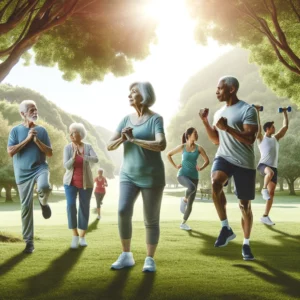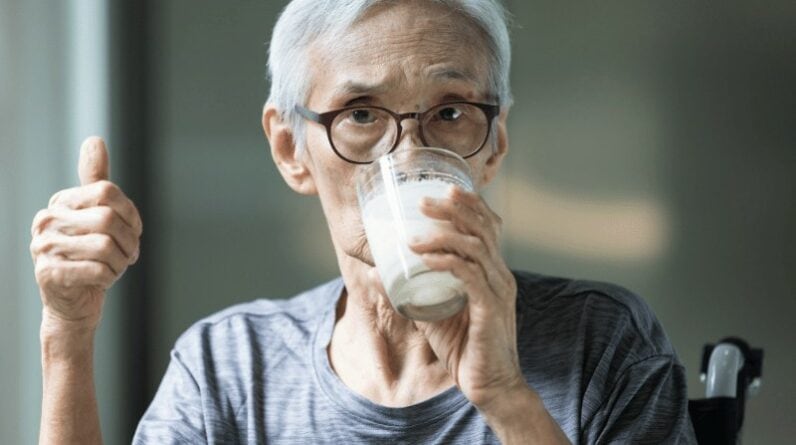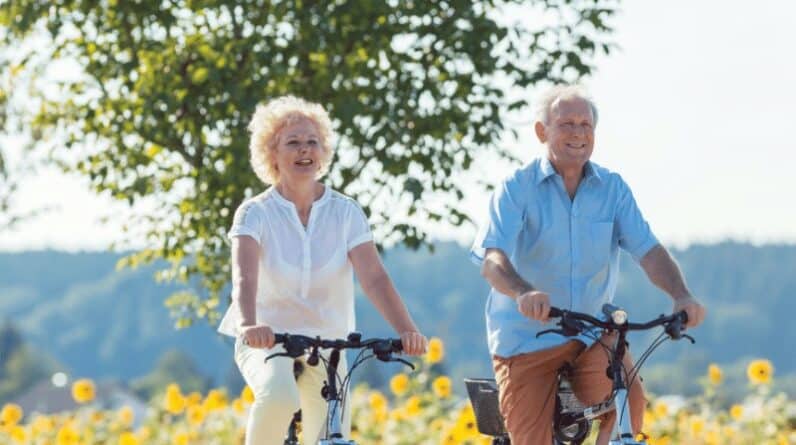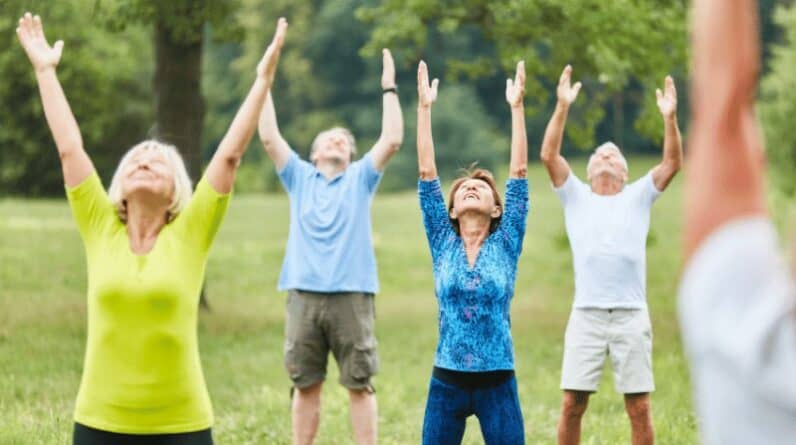Embracing an Active Lifestyle: The Golden Years’ Gateway to Wellbeing


Dementia Discovery That is Leaving Doctors Speechless (Try This Tonight)
Better than Morphine For Joint Pain… Yet Safer Than Aspirin?
Retire With Freedom. Start Earning Extra Cash Today.
Understanding the benefits of staying active for seniors
Staying active in senior years is not just about maintaining physical health; it’s a vital component of overall well-being that can significantly enhance the quality of life.
As individuals age, their bodies undergo various changes, making it essential to stay active to combat these transformations effectively.
Engaging in regular physical activity can have profound benefits for seniors, including improved cardiovascular health, enhanced muscle strength, and better bone density.
Cardiovascular exercises, such as walking or swimming, can help reduce the risk of heart diseases, which are prevalent in older adults.
Strength training, even with light weights or bodyweight exercises, aids in maintaining muscle mass and bone strength, crucial for everyday activities and preventing falls.
Moreover, the benefits of staying active extend beyond the physical aspects. For seniors, regular exercise can be a powerful tool for mental health.
It has been shown to reduce the risk of cognitive decline and diseases such as Alzheimer’s. Physical activity stimulates the brain and can help improve memory and cognitive function.
Additionally, staying active often involves social interaction, whether it’s a group exercise class, a walking club, or a dance class.
These social connections are invaluable for mental and emotional health, helping to combat feelings of isolation and depression that some seniors may experience.
Furthermore, the sense of accomplishment and independence gained from maintaining an active lifestyle can boost self-esteem and overall life satisfaction, making the golden years truly golden.
How regular activity contributes to longevity and quality of life
Regular physical activity is a cornerstone of healthy living, significantly contributing to increased longevity and a better quality of life.
Numerous studies have established a clear link between consistent exercise and a reduced risk of chronic diseases, such as heart disease, diabetes, and certain cancers.
Regular activity helps maintain a healthy weight, reduces blood pressure, and improves cholesterol levels, all of which are critical factors in extending lifespan.
Moreover, engaging in physical activities, especially those that elevate the heart rate, enhances cardiovascular health, ensuring the heart remains strong and efficient even into older age.
This enhanced heart function is vital for longevity, as it reduces the risk of heart-related ailments, which are among the leading causes of mortality worldwide.
Beyond the physical benefits, regular activity profoundly impacts mental and emotional well-being, contributing to an improved quality of life.
Exercise releases endorphins, known as the body’s natural mood lifters, which can alleviate symptoms of depression and anxiety.
This is particularly important as mental health is a significant component of overall well-being. Additionally, staying active often involves social engagement, providing opportunities to connect with others, share experiences, and build supportive communities.
These social aspects are crucial for mental health, especially as people age. Furthermore, regular activity promotes better sleep, enhances cognitive function, and increases overall energy levels.
This combination of physical, mental, and social benefits ensures that individuals not only live longer but also enjoy a richer, more fulfilling life.
Addressing common misconceptions about seniors and activity levels
One prevalent misconception about seniors and activity levels is the belief that aging inevitably leads to a significant decline in physical capabilities, thus warranting a sedentary lifestyle.
This stereotype fosters the idea that exercise is either unsafe or ineffective for older adults. However, this is far from the truth.
While it’s undeniable that aging can bring physical changes, such as reduced muscle mass and joint flexibility, it doesn’t mean seniors are incapable of exercising.
In fact, with proper guidance and modifications, seniors can engage in a variety of physical activities, ranging from low-impact exercises like swimming and yoga to more robust activities like walking and cycling.
Research consistently shows that seniors who stay active experience numerous health benefits, including improved strength, better balance, and enhanced cardiovascular health.
Furthermore, regular exercise can significantly slow down the aging process and mitigate the risks of many age-related diseases.
Another common misconception is the notion that it’s too late for seniors to start exercising if they were not active earlier in life.
This leads to the mistaken belief that the benefits of exercise are reserved only for those who have been consistently active throughout their lives. However, studies have shown that it’s never too late to start.
Seniors who begin exercising, even later in life, can still reap significant health benefits. Starting a routine of regular physical activity can lead to immediate improvements in aspects like mood, mobility, and overall vitality.
This can be especially transformative for seniors who may have developed chronic conditions or mobility issues, as even moderate levels of exercise can lead to improvements in managing these conditions.
It’s essential to dispel these misconceptions and promote a more inclusive and positive view of seniors’ capabilities, encouraging them to embrace an active lifestyle for better health and quality of life.
Tailoring Physical Activities: Safe and Enjoyable Options for Seniors
Different types of activities suitable for various fitness levels
When considering physical activities for different fitness levels, it’s important to recognize that exercise is not a one-size-fits-all endeavor.
Each individual’s fitness level, health status, preferences, and goals play a crucial role in determining the most suitable types of activities. For beginners or those with lower fitness levels, starting with low-impact exercises is often recommended.
Activities such as walking, swimming, tai chi, and gentle yoga are excellent choices. These activities are less stressful on the joints, reduce the risk of injury, and are generally easier to start with for those who are new to exercising or returning after a long break.
Walking, in particular, is highly accessible and can be easily incorporated into daily routines. Swimming and water aerobics offer the resistance of water for a good workout while being gentle on the body.
Tai chi and yoga, aside from improving physical fitness, also offer mental and emotional benefits through their meditative and relaxation components.
For individuals with a moderate fitness level, there are a variety of options that can help maintain or improve their fitness.
These might include brisk walking, jogging, cycling, dancing, and resistance training with light weights or bodyweight exercises. These activities help improve cardiovascular health, increase muscle strength, and enhance endurance.
They can be adjusted in intensity to suit personal fitness levels and can often be done in group settings for added motivation and social interaction.
For those who are more advanced in their fitness journey, high-intensity interval training (HIIT), running, advanced yoga or pilates, and heavier weight training can be beneficial.
These activities require more physical exertion and are excellent for improving athletic performance, and building muscle strength, and endurance.
Individuals at this level need to pay attention to proper form and technique to prevent injuries. No matter the fitness level, individuals must choose activities they enjoy, as this increases the likelihood of consistency and long-term commitment to an active lifestyle.
Adapting exercises for mobility or health concerns
Adapting exercises to accommodate mobility or health concerns is crucial for ensuring that everyone can participate in physical activity safely and effectively.
Individuals with limited mobility, chronic health conditions, or age-related issues often face unique challenges in exercising.
However, with proper adaptation and guidance, they can still engage in meaningful physical activities that contribute to their overall health and well-being.
For instance, chair exercises are an excellent option for those with limited mobility or balance issues. These exercises can range from seated strength training with light weights or resistance bands to aerobic movements that raise the heart rate while minimizing stress on the joints.
Similarly, water-based exercises like aqua aerobics or swimming provide buoyancy, which reduces impact on the body, making them ideal for those with joint pain or arthritis.
When adapting exercises for those with health concerns, it’s vital to consider the specific limitations and needs of each individual.
For example, individuals with heart conditions may require low-intensity activities that don’t overly strain the cardiovascular system.
Walking at a gentle pace or doing light stretching exercises can be beneficial in such cases. For those with respiratory issues, exercises that focus on gentle movement and breathing techniques, like tai chi or gentle yoga, can be particularly helpful.
It’s also essential to incorporate flexibility and balance exercises, which are often overlooked but crucial for preventing falls and improving overall mobility.
Consulting with healthcare professionals, such as physical therapists or exercise physiologists, can provide valuable insights into creating a personalized exercise plan that takes into account an individual’s health concerns.
This personalized approach ensures that the exercises are not only safe but also effective in improving health and quality of life.
Examples of low-impact exercises ideal for seniors
Low-impact exercises are ideal for seniors as they provide the benefits of physical activity while minimizing the risk of injury and strain on the body. One of the most accessible and beneficial low-impact exercises for seniors is walking.
It’s a simple yet effective way to maintain cardiovascular health, improve muscle strength, and enhance balance and coordination.
Walking can be easily adjusted to an individual’s fitness level and can be done anywhere, from parks to walking tracks, or even around the neighborhood. It’s also a great way to enjoy the outdoors and can be a social activity if done with friends or family.
Another excellent low-impact exercise is water aerobics or swimming. The buoyancy of water supports the body and reduces stress on the joints, making it an ideal exercise medium for seniors, especially those with arthritis or joint pain.
Water exercises improve cardiovascular health, increase muscle strength, and enhance flexibility, all while being gentle on the body.
Yoga and Tai Chi are other forms of low-impact exercises that are particularly beneficial for seniors. These exercises focus on gentle movements, stretching, and balance, which are essential for maintaining flexibility and preventing falls.
Yoga and Tai Chi also have the added benefit of promoting relaxation and mental well-being, thanks to their meditative aspects. They can improve posture, mobility, and even cognitive function, making them a holistic approach to aging healthily.
Additionally, stationary cycling or using a recumbent bike can provide a good cardiovascular workout without the high impact of running or jogging.
These exercises can be done at a comfortable pace and intensity, allowing seniors to build endurance and strength safely. Incorporating these low-impact exercises into a routine can significantly contribute to maintaining and improving the overall health and quality of life for seniors.
Starting Small: Simple Steps to Incorporate Movement into Daily Routines
Easy ways seniors can be more active throughout the day
For seniors looking to integrate more activity into their daily routine, several easy and practical strategies can be adopted.
One effective method is to incorporate short, frequent bouts of activity throughout the day. This can be as simple as taking regular short walks, whether it’s around the house, in the garden, or down the street.
Setting a timer to stand up and move every hour can also be beneficial, especially for those who tend to sit for extended periods.
Simple household chores like gardening, vacuuming, or even light dusting can be a great way to stay active, offering the dual benefits of a cleaner living space and physical movement.
Additionally, seniors can choose to take the stairs instead of the elevator whenever possible, which is a fantastic way to strengthen the legs and improve cardiovascular health in a very natural way.
Another easy approach for seniors to increase their activity level is to turn everyday activities into opportunities for exercise.
For instance, performing calf raises while standing at the sink, doing seated leg lifts while watching TV, or incorporating arm circles while waiting for the kettle to boil are innovative ways to sneak in some extra movement.
Engaging in hobbies that require physical activity, such as dancing, bowling, or playing light sports like table tennis, can also be both enjoyable and beneficial for maintaining physical health.
Seniors can also consider joining group exercise classes tailored for their age group, which not only helps with staying active but also provides social interaction.
Walking clubs, yoga classes for seniors, or water aerobics groups are just a few examples of how they can combine social engagement with physical activity.
By finding creative ways to weave movement into their daily lives, seniors can significantly enhance their overall health and well-being without the need for strenuous exercise routines.
Tips for building a routine that encourages regular movement
Building a routine that encourages regular movement is essential for sustaining a healthy lifestyle, and the key to success lies in creating a plan that is both realistic and enjoyable.
One of the most important tips is to set achievable goals. Instead of aiming for long, intense workouts right away, start with shorter, more manageable periods of activity.
This could be as simple as a 10-minute walk, a few minutes of stretching, or a brief yoga session each day. Gradually increasing the duration and intensity of these activities over time helps in building stamina and prevents the risk of burnout or injury.
It’s also crucial to incorporate a variety of activities to keep the routine interesting and to work different muscle groups.
Mixing cardiovascular exercises like walking or swimming with strength training, flexibility exercises, and balance training can provide a comprehensive workout and prevent monotony.
Consistency is another vital aspect of building an effective routine. Scheduling specific times for physical activity and treating them as important appointments can significantly increase adherence to the routine.
It helps to choose times of the day when energy levels are highest, as this makes it more likely that the exercise will be completed.
Moreover, tracking progress can be highly motivating. Keeping a simple journal or using a fitness app to log activities can provide a sense of accomplishment and help in setting new goals.
Additionally, involving friends or family members in the exercise routine can provide a support system and make the activities more enjoyable.
Whether it’s a walking group, a dance class, or a regular swim with a friend, having a partner can increase accountability and make exercising a social and fun experience.
By following these tips and listening to one’s body, anyone can build a sustainable routine that naturally incorporates regular movement into their daily life.
The role of everyday chores in maintaining activity levels
Everyday chores play a surprisingly significant role in maintaining activity levels, especially for those who may find it challenging to incorporate structured exercise into their daily routine. Engaging in regular household tasks is a practical and natural way to stay active.
Activities like vacuuming, sweeping, dusting, or even doing the dishes involve a range of motions such as bending, stretching, and lifting, which can help keep the joints flexible and the muscles engaged.
Gardening, for instance, is not only a peaceful and rewarding hobby but also a great way to engage in moderate physical activity. It involves various movements like digging, planting, weeding, and watering, which contribute to muscle strength and endurance.
Even small tasks like organizing a closet or tidying up rooms require physical effort that can accumulate a significant amount of low-impact exercise throughout the day.
Additionally, turning chores into more deliberate exercise opportunities can further enhance their benefits.
For example, incorporating calf raises while ironing, doing squats while loading the washing machine, or practicing balance exercises while brushing teeth can transform mundane activities into valuable exercise moments.
This approach is particularly beneficial for those who have limited time or ability to engage in traditional forms of exercise.
It also fosters a mindset where physical activity is seamlessly integrated into everyday life, rather than being seen as a separate or special task.
This integration helps in establishing long-term habits of movement and can significantly contribute to overall health and well-being.
By recognizing and utilizing the physical demands of daily chores, individuals can maintain and even improve their activity levels conveniently and cost-effectively.
Mental Moves: Cognitive Exercises to Complement Physical Activity
Importance of cognitive health and its relationship with physical activity
The importance of cognitive health, particularly as we age, cannot be overstated, and its relationship with physical activity is a critical aspect of maintaining mental acuity and overall brain health.
Regular physical activity has been consistently linked to better cognitive function. Exercise, especially aerobic activities that increase the heart rate, drives more oxygen-rich blood to the brain, which is essential for the nourishment and functioning of brain cells.
This increased blood flow also promotes the growth of new brain cells and the connections between them, enhancing cognitive abilities like memory, attention, and problem-solving skills.
Moreover, physical activity has been shown to reduce the risk of cognitive decline and neurodegenerative diseases such as Alzheimer’s and dementia.
The endorphins released during exercise not only help in reducing stress and anxiety but also play a role in improving mood and sleep, which are crucial for cognitive health.
Beyond the physical benefits, engaging in regular physical activity often includes a social component, whether it’s a group exercise class, a walking group, or a team sport.
Social interaction itself is beneficial for cognitive health, as it stimulates the brain through conversation and shared activities.
Furthermore, learning new physical skills or routines, such as dance steps, yoga poses, or exercise sequences, can also be mentally stimulating and contribute to cognitive resilience.
This aspect of learning and adaptation is particularly important for the aging brain, as it encourages neuroplasticity – the brain’s ability to form and reorganize synaptic connections, especially in response to learning or experience.
Therefore, maintaining an active lifestyle is not only about physical health but is also intrinsically linked to preserving and enhancing cognitive function, highlighting the importance of incorporating regular physical activity into our daily routines for holistic well-being.
Brain training activities that can be done alongside physical exercises
Brain training activities, when combined with physical exercises, create a powerful duo for enhancing both cognitive and physical health.
One effective approach is to engage in activities that require both mental and physical coordination. For example, exercises like tai chi or yoga not only involve physical movement but also require concentration, memory, and spatial awareness.
The sequences and poses in these practices challenge the brain to remember and execute complex movements, providing a cognitive workout alongside the physical one.
Similarly, dance is an excellent way to blend physical activity with brain training.
Learning new dance routines involves coordination, rhythm, and memory, making it an enjoyable and effective way to stimulate the brain while also improving cardiovascular health, balance, and muscle strength.
Another way to incorporate brain training into physical exercise is through activities that involve strategy and problem-solving.
Sports like tennis or golf require not only physical skill but also strategic thinking and concentration.
These activities demand focus, planning, and quick decision-making, which are excellent for cognitive stimulation.
Additionally, simple modifications to regular exercises can add a cognitive challenge. For instance, counting backward or reciting something while walking or jogging can enhance mental agility.
Using dual-task exercises, such as balancing on one leg while doing a cognitive task like naming countries or states in alphabetical order, can also be effective.
These combinations of cognitive tasks and physical movements encourage the brain and body to work together, reinforcing neural connections and promoting overall brain health.
By integrating brain training with physical exercises, individuals can enjoy a holistic approach to health that benefits both the mind and body.
Interactive games and challenges to keep the mind sharp
Interactive games and challenges are excellent tools for keeping the mind sharp, combining enjoyment with mental stimulation.
Brain-teasing games such as puzzles, crosswords, Sudoku, and memory games are popular choices that challenge cognitive abilities like problem-solving, pattern recognition, and recall.
Engaging in these activities regularly can help improve mental agility, focus, and concentration.
Modern technology has further expanded the scope of interactive brain games through apps and online platforms, which offer a variety of cognitive exercises designed to target different areas of brain function.
These digital games often adapt to the user’s skill level, progressively becoming more challenging to keep the brain engaged and stimulated.
Additionally, social interaction games like board games, card games, or trivia quizzes are not only fun but also cognitively enriching.
These games require strategic thinking, memory, and quick decision-making, often under time constraints.
Playing these games with friends or family members adds a social element, which is beneficial for mental health and can enhance cognitive skills through social cues and communication.
Role-playing games (RPGs) or interactive storytelling games provide a creative outlet for imagination and strategic thinking.
They encourage players to make decisions based on complex scenarios, promoting critical thinking and problem-solving skills.
Moreover, engaging in friendly competitions or challenges, such as a weekly trivia night or a puzzle-solving contest, can add an element of excitement and motivation to keep the mind active.
These interactive games and challenges are not only enjoyable but also serve as effective tools for keeping the mind sharp and active, contributing to overall cognitive health.
Connecting with Others: Group Activities and Social Interaction

How group activities can enhance motivation and enjoyment
Group activities play a pivotal role in enhancing both motivation and enjoyment, especially when it comes to exercise or learning new skills.
The social aspect of group activities creates a supportive and encouraging environment, making it easier for individuals to commit to and persist in their endeavors.
For instance, in a group exercise class, the presence of others can be a powerful motivator. People often push themselves harder in a group setting than they would on their own, driven by the group’s energy and the desire not to fall behind.
This peer encouragement can significantly boost one’s own effort and commitment levels. Additionally, group activities can introduce an element of accountability; knowing that others expect your participation can be a strong incentive to show up and participate regularly.
Beyond motivation, group activities greatly enhance the enjoyment factor. Engaging in activities with others can transform a routine task into a more enjoyable and meaningful experience.
Whether it’s a group dance class, a team sport, or a communal art project, the joy derived from shared experiences is invaluable. These activities provide opportunities for social interaction, laughter, and camaraderie, which are essential for mental and emotional well-being.
Furthermore, group settings often lead to the formation of friendships and social networks, which can provide emotional support and a sense of belonging.
Learning in a group setting can also be more enriching, as individuals can benefit from the diverse perspectives and experiences of other group members.
The shared challenges and achievements in a group context foster a sense of community and collective accomplishment, enhancing the overall enjoyment of the activity.
Therefore, group activities are not just about the physical or intellectual benefits; they also cater to our inherent need for social connection, making them a vital component of a balanced and fulfilling life.
Finding local senior groups or events focused on physical activity
Finding local senior groups or events focused on physical activity is an excellent way for older adults to stay active, socialize, and engage with their community.
Many communities offer a variety of resources specifically tailored for seniors. Local community centers, senior centers, and YMCAs are often great starting points.
These institutions frequently host exercise classes, walking clubs, dance groups, or yoga sessions designed for seniors. Such programs are not only geared towards accommodating different physical abilities but also provide a safe and supportive environment for seniors to engage in physical activity.
Additionally, many of these centers organize special events like health fairs, fitness challenges, or group outings, which can be both fun and beneficial for overall health.
Another valuable resource for finding senior-focused physical activities is the public library or city recreation department.
These often list local events and activities in community newsletters or bulletins. Furthermore, the advent of technology has made it easier to locate such groups and events.
Many communities have websites or social media pages dedicated to senior activities where one can find information about upcoming events or join online forums and groups.
For those who prefer more organized activities, some clubs and organizations cater specifically to seniors, offering a range of physical activities from golf leagues to swimming clubs.
Engaging with these groups not only helps in maintaining physical fitness but also provides a platform for social interaction and building friendships, which is crucial for emotional and mental well-being at any age.
By actively seeking out and participating in these local groups and events, seniors can find enjoyable ways to stay active and connected within their communities.
Virtual options for staying active and connected
In today’s digital age, virtual options have opened up a new and accessible way for people to stay active and connected, especially important for those who may face limitations in accessing physical venues.
Online exercise classes have become increasingly popular, offering a wide range of activities suitable for various fitness levels and interests.
From yoga and pilates to dance and strength training, these virtual classes provide the flexibility to participate in guided workouts from the comfort of one’s home.
This is particularly beneficial for seniors or individuals with mobility issues, as it removes the barrier of transportation and provides a safe, private environment to exercise.
Additionally, many of these classes are recorded, allowing participants to access them at their convenience, catering to different schedules and time zones.
Beyond exercise, virtual platforms also offer incredible opportunities for social connection and mental stimulation.
Online clubs, forums, and social groups bring together people with shared interests, whether it’s a book club, a gardening group, or a cooking class.
Video conferencing tools like Zoom or Skype enable face-to-face interaction, making these gatherings more personal and engaging. For seniors, this can be a vital link to the outside world, helping to combat feelings of isolation and loneliness.
Virtual gaming platforms and apps that offer brain-training games, puzzles, and trivia also provide a fun way to keep the mind active and engage with others.
These online options not only help in maintaining physical and cognitive health but also ensure that individuals remain socially active, which is a crucial aspect of overall well-being.
The convenience and accessibility of virtual options have made it easier than ever to stay active and connected, no matter where one is located.
Setting Realistic Goals: The Key to Sustained Senior Fitness
How to set achievable and meaningful fitness goals as a senior
Setting achievable and meaningful fitness goals as a senior is a crucial step towards maintaining health and independence. The key lies in creating realistic, personalized objectives that align with one’s own health status, lifestyle, and interests.
Seniors need to start by consulting with healthcare professionals, such as a doctor or physical therapist, to understand any limitations or specific needs they might have.
Based on this, goals can be tailored to individual capabilities, such as improving balance, enhancing flexibility, increasing walking distance, or building strength to perform daily activities more easily.
Instead of focusing on ambitious or vague goals like “getting fit,” more specific and measurable objectives like “walking for 20 minutes a day, three times a week” or “attending two yoga classes per week” are more effective.
These smaller, clearly defined goals are not only more manageable but also provide a sense of accomplishment when achieved, which is crucial for motivation.
In addition to physical goals, it’s important to consider the emotional and social aspects of fitness.
For example, joining a group exercise class can provide social interaction and accountability, making the goal not just about physical fitness but also about community involvement and social engagement.
Setting goals that incorporate these broader benefits can enhance the overall enjoyment and fulfillment derived from staying active. It’s also important for seniors to be flexible and patient with their progress.
As the body ages, it may take longer to see results, and there may be good days and bad days. Adjusting goals as needed, celebrating small victories, and maintaining a positive, patient attitude are essential components of a successful fitness journey in later years.
By setting achievable, meaningful goals and approaching them with a holistic mindset, seniors can greatly enhance their quality of life and overall well-being.
Importance of consistency and patience in reaching activity milestones
Consistency and patience are fundamental in reaching activity milestones, especially in the context of fitness and health goals.
Consistency is the key to making gradual improvements and achieving long-term success. Regularly engaging in physical activity, even in smaller amounts, is far more beneficial than sporadic, intense workouts.
This steady approach allows the body to adapt and improve over time, reducing the risk of injury and burnout. For example, a consistent walking routine, even if it’s just for 15 minutes a day, can lead to significant improvements in cardiovascular health, muscle strength, and mental well-being over time.
Consistency also helps in forming habits; when an activity becomes a regular part of one’s routine, it’s less likely to be skipped and more likely to be improved upon.
This is particularly important for those starting a new exercise regimen or trying to reintegrate physical activity into their daily life.
Patience, on the other hand, is crucial in managing expectations and maintaining motivation. Physical and health improvements often take time, and progress might not always be linear or as rapid as one might hope.
This is especially true as we age, where changes in fitness levels and body responses may not be as quick as in younger years. It’s important to be patient and recognize that even small steps forward are significant achievements.
Celebrating these small milestones helps in building confidence and sustaining motivation. Patience also involves understanding and accepting one’s body limitations and recognizing that some days might be more challenging than others.
This acceptance allows for a more forgiving and flexible approach to fitness, which is essential for long-term adherence and success.
By combining consistency with patience, individuals can create a sustainable path toward reaching their activity milestones, ensuring that the journey is as rewarding as the destination.
Celebrating small victories to maintain motivation
Celebrating small victories is a crucial strategy in maintaining motivation, particularly when it comes to long-term goals like fitness or personal development.
Small victories are the incremental steps taken toward achieving a larger goal. Acknowledging and celebrating these steps keeps morale high and provides a sense of accomplishment.
For instance, in a fitness journey, a small victory could be completing a workout without skipping, adding a few more minutes to a walk, or successfully performing a previously challenging exercise.
Recognizing these achievements, no matter how minor they seem, reinforces positive behavior and creates a feedback loop that motivates further action.
Celebrating these moments can be as simple as acknowledging the effort out loud, treating oneself to a healthy reward, or sharing the achievement with friends or family.
This recognition not only boosts self-esteem but also helps to break down a daunting goal into manageable, attainable segments, making the overall process less overwhelming.
In addition, celebrating small victories helps in maintaining a positive outlook, which is essential for long-term commitment.
It’s easy to become discouraged when focusing solely on the end goal, especially if it seems far off or difficult to achieve.
By shifting focus to the progress being made, no matter how small, it’s easier to stay motivated and committed.
Furthermore, this practice helps in building a growth mindset, where the journey and the learning process are valued just as much as the outcome.
It encourages a shift from a “success or failure” perspective to one of continuous improvement and perseverance.
In essence, celebrating small victories is not just about acknowledging achievements, but also about cultivating a positive, resilient attitude that is crucial for overcoming challenges and achieving long-term success.
Navigating Health Limitations: Consulting with Healthcare Providers
The importance of medical advice in planning safe workouts
The importance of seeking medical advice before planning workouts, especially for individuals with pre-existing health conditions, those who are new to exercise, or older adults, cannot be overstated.
Medical professionals can provide valuable insights into how various types of exercise may impact an individual’s specific health concerns.
For example, people with heart conditions, high blood pressure, joint problems, or diabetes may require tailored exercise programs to ensure safety and effectiveness.
A doctor or a physical therapist can advise on the types and intensities of exercise that are safe, taking into account the person’s current health status, medication, and overall physical capabilities.
This guidance is crucial in preventing injuries and avoiding exacerbation of existing health issues.
Additionally, they can offer advice on how to gradually increase the intensity of workouts, which is essential for building endurance and strength safely.
Moreover, consulting with healthcare professionals is particularly important for those who have been sedentary or are planning to significantly change their level of physical activity.
A medical evaluation can help in setting realistic and safe fitness goals. Healthcare providers can also offer advice on how to recognize and respond to signs of overexertion or distress during exercise, which is critical for avoiding medical emergencies.
In some cases, they might recommend supervised exercise programs, particularly for individuals with specific health risks.
These programs are often conducted by trained professionals who can monitor the individual’s response to exercise and adjust the regimen as necessary.
Seeking medical advice before starting or modifying an exercise routine is not just a precautionary measure; it’s a fundamental step in ensuring that the workouts contribute positively to one’s health and well-being, rather than posing a risk.
Adjusting fitness plans in response to health changes
Adjusting fitness plans in response to health changes is a crucial aspect of maintaining a safe and effective exercise routine.
Our bodies and health conditions can change over time due to various factors such as aging, illness, injury, or lifestyle changes.
These changes can affect our physical capabilities and exercise tolerance, necessitating modifications to our fitness routines.
For example, someone who used to run regularly might experience joint pain or arthritis and may need to switch to lower-impact activities like walking or swimming.
Similarly, recovering from surgery or a health setback like a cardiac event requires a gradual reintroduction of physical activity, often under the guidance of a medical professional.
In such cases, the intensity, duration, and type of exercises need to be carefully adjusted to align with the current health status and recovery process.
Furthermore, adjusting fitness plans isn’t just about scaling back when facing health challenges; it also involves adapting to improvements in health.
For instance, someone who has successfully managed a health condition like diabetes or hypertension through medication and lifestyle changes may find they are capable of more strenuous activities than before.
In these scenarios, it’s important to reassess fitness goals and gradually increase the challenge of the workouts to continue making progress. In all cases, listening to the body and being attentive to its responses during and after exercise is crucial.
Feeling unusual pain, excessive fatigue, or other discomforts are signs that the current fitness plan may need adjustment.
Regular consultation with healthcare professionals, such as a doctor or a physiotherapist, can provide valuable guidance on how to safely adjust exercise plans in response to health changes.
By being adaptable and responsive to the body’s needs, individuals can continue to enjoy the benefits of physical activity throughout various stages of their health journey.
How healthcare providers can be partners in active living strategies
Healthcare providers play a pivotal role as partners in active living strategies, offering expert guidance and support to individuals seeking to lead a healthier lifestyle.
They are instrumental in providing personalized advice that aligns with an individual’s specific health needs, limitations, and goals.
For instance, a primary care physician can assess overall health status, identify any risk factors, and recommend appropriate types of physical activity.
This might include advising on the intensity and frequency of exercise, particularly for those with chronic conditions like heart disease, diabetes, or arthritis.
Healthcare providers can also monitor progress and adjust recommendations as health conditions change or improve.
In cases where specialized knowledge is required, they can refer patients to experts such as physical therapists, dietitians, or exercise physiologists who can tailor exercise and nutrition plans to individual needs.
Beyond offering medical advice, healthcare providers can also be motivational allies. They can encourage patients by recognizing their efforts and achievements in pursuing a more active lifestyle.
This encouragement is especially important for individuals who may feel overwhelmed or uncertain about how to start being more active.
Healthcare providers can set realistic expectations and help patients celebrate small victories, which is crucial for maintaining motivation.
Additionally, they can provide resources and information about local exercise programs, community groups, or online platforms that offer support for active living.
This partnership between healthcare providers and patients is not just about managing or preventing health conditions, but also about enhancing overall well-being, quality of life, and longevity.
By working collaboratively with healthcare providers, individuals can develop sustainable active living strategies that are safe, effective, and enjoyable.
Feeding Your Fitness: Nutrition’s Role in Supporting an Active Senior Life
Nutritional requirements for active seniors
For active seniors, meeting nutritional requirements is crucial to support their physical activities and overall health.
As we age, our bodies undergo various changes, including a natural decline in metabolism and alterations in body composition, such as reduced muscle mass.
Therefore, the diet of an active senior should be carefully balanced to ensure it provides the necessary energy and nutrients.
Protein plays a vital role in maintaining and repairing muscle tissue, especially important for those engaged in regular physical activity.
Seniors should aim for a diet rich in lean protein sources like poultry, fish, beans, and legumes, which help in preserving muscle mass and strength.
Additionally, calcium and vitamin D are essential for bone health, reducing the risk of fractures and osteoporosis. Dairy products, fortified cereals, and fatty fish, along with appropriate sun exposure, can help meet these needs.
Equally important is the intake of complex carbohydrates, which provide a steady source of energy.
Whole grains, fruits, and vegetables not only supply carbohydrates but are also rich in fiber, vitamins, and antioxidants, supporting overall health and aiding digestion. Hydration is another key aspect that active seniors need to focus on.
With advancing age, the sense of thirst may diminish, increasing the risk of dehydration, particularly during physical exertion.
Regular intake of fluids, preferably water, is essential to maintain hydration levels. Seniors should also be mindful of their micronutrient intake.
As the ability to absorb certain nutrients decreases with age, a diet rich in a variety of nutrients, including B vitamins, potassium, and omega-3 fatty acids, is beneficial.
In some cases, dietary supplements may be necessary, but it’s important to consult with healthcare professionals before starting any supplementation.
Tailoring the diet to meet these nutritional needs helps active seniors maintain their energy levels, improve recovery after exercise, and support overall health.
Balancing diet and exercise for optimal health
Balancing diet and exercise is a cornerstone of achieving and maintaining optimal health. These two components work synergistically, each enhancing the benefits of the other.
A well-balanced diet provides the necessary fuel and nutrients for physical activities, while regular exercise improves metabolism, muscle strength, and overall body function, which in turn can influence dietary choices and nutritional needs.
For effective results, the diet should match the level of physical activity. For instance, those engaging in high-intensity or endurance exercises may require a higher intake of carbohydrates for energy, along with adequate proteins for muscle repair and recovery.
Conversely, a more sedentary lifestyle would call for a lower calorie intake to avoid weight gain. Regardless of the activity level, the diet should be rich in whole foods, including a variety of fruits, vegetables, lean proteins, whole grains, and healthy fats, providing a wide range of essential nutrients.
In addition to what is eaten, hydration plays a critical role in both diet and exercise. Adequate fluid intake is essential for maintaining energy levels, proper muscle function, and overall health.
During exercise, water helps regulate body temperature and lubricate joints, making physical activity safer and more effective.
Furthermore, the timing of meals and snacks can influence exercise performance and recovery. Eating a light, nutritious snack or meal before exercising can provide energy and improve endurance, while a balanced post-exercise meal can aid in recovery and muscle repair.
It’s also important to listen to the body’s hunger and fullness cues, eating when hungry but avoiding overeating.
This balance between diet and exercise not only helps in maintaining a healthy weight but also contributes to improved mental health, better sleep, and a reduced risk of chronic diseases.
By carefully aligning dietary habits with physical activity levels, individuals can create a harmonious and sustainable approach to achieving optimal health.
How to stay active as a senior-Meal planning tips for energy and recovery
Meal planning is crucial for ensuring a balanced diet that supports both energy for activity and recovery post-exercise.
For those engaging in regular physical activity, it’s important to plan meals that are rich in complex carbohydrates, lean proteins, and healthy fats.
Complex carbohydrates, found in foods like whole grains, legumes, fruits, and vegetables, provide a sustained energy source that is essential for fueling the body during exercise.
These foods also supply the necessary fiber, vitamins, and minerals to support overall health. Lean proteins, such as chicken, fish, tofu, and legumes, are essential for muscle repair and recovery after exercise.
Including a source of protein in each meal helps with the rebuilding of muscle tissue that breaks down during physical activity.
In addition to macronutrients, hydration, and timing play a significant role in meal planning. Staying well-hydrated is crucial, as water supports metabolic functions and nutrient transport in the body. It’s also important to time meals and snacks to coincide with energy needs.
Eating a meal or snack that includes carbohydrates and a moderate amount of protein about 1-2 hours before exercising can provide the energy needed for the activity.
After exercising, it’s beneficial to consume a meal or snack that includes proteins and carbohydrates within 45 minutes to an hour. This helps replenish glycogen stores and aids in muscle recovery.
Planning meals ensures that these nutritional needs are met without the stress of last-minute decisions. Preparing and portioning meals ahead of time can also help control portion sizes and maintain a balanced diet.
By focusing on nutrient-rich foods and proper timing, meal planning can significantly contribute to sustained energy levels and effective recovery in an active lifestyle.
Sustaining Activity into the Future: Long-Term Strategies for Seniors
Strategies to keep the momentum going
Keeping the momentum going in any endeavor, whether it’s related to fitness, work, or personal projects, often requires a combination of strategic planning and psychological motivation.
One effective strategy is to set clear, achievable goals. These goals should be specific, measurable, attainable, relevant, and time-bound (SMART).
By breaking down larger objectives into smaller, manageable tasks, the process becomes less overwhelming and more achievable.
Celebrating small victories along the way is crucial for maintaining motivation. Acknowledging progress, no matter how minor it may seem, can provide a significant psychological boost and reinforce the desire to continue.
Another key strategy is to establish a routine or habit. Consistency is often more impactful than intensity in sustaining momentum.
Creating a daily or weekly routine that incorporates the necessary steps toward achieving your goals can make the process a part of your regular life, reducing the effort needed to make decisions about when or how to engage in the activity.
Additionally, having a support system can be immensely beneficial. This could be in the form of a mentor, a peer group, or friends and family who encourage and support your efforts.
Sharing your goals and progress with others can provide accountability and a sense of community, which are powerful motivators.
Finally, it’s important to remain flexible and adaptable. Setbacks and challenges are inevitable, but viewing them as opportunities to learn and grow, rather than as failures, can help maintain momentum.
Adjusting plans and strategies in response to new information or circumstances keeps the journey toward your goals dynamic and resilient.
Adapting activity levels with age and ability
Adapting activity levels with age and ability is essential for maintaining a healthy and sustainable lifestyle.
As we age, our bodies naturally undergo various changes, such as a decrease in muscle mass, bone density, and flexibility, as well as potential health issues like arthritis or cardiovascular problems.
Acknowledging and adapting to these changes is crucial for preventing injuries and ensuring that physical activities remain beneficial and enjoyable.
For seniors or those with reduced physical abilities, low-impact exercises such as walking, swimming, tai chi, or gentle yoga can be ideal.
These activities provide the benefits of exercise while minimizing strain on the body. They help maintain cardiovascular health, flexibility, and balance, which are key to preserving independence and quality of life in older age.
Moreover, it’s important to focus on exercises that enhance functional fitness – the ability to perform everyday activities with ease.
Strength training, even with light weights or resistance bands, can help maintain muscle strength and joint function, critical for day-to-day tasks.
Balance exercises are also vital for preventing falls, a common concern for older adults. Regular physical activity should be complemented by adequate rest and recovery time, as the body’s healing processes tend to slow down with age.
In addition to adapting the type and intensity of physical activities, it’s also essential to listen to one’s body and respect its limits.
This might mean shorter exercise sessions, incorporating more rest days, or modifying exercises to accommodate any health issues or disabilities.
Consulting with healthcare professionals, such as doctors or physical therapists, can guide in creating an exercise plan that aligns with one’s changing age and abilities.
By adapting activity levels appropriately, individuals can continue to enjoy the benefits of physical activity at any age, while minimizing the risk of injury and other health complications.
How to stay motivated and avoid plateaus in senior fitness journeys
Staying motivated and avoiding plateaus in senior fitness journeys requires a multifaceted approach that combines variety, goal-setting, and a keen understanding of one’s own body and interests.
Firstly, incorporating variety into a fitness routine is crucial. Engaging in the same type of exercise every day can become monotonous and may lead to a plateau in physical improvements.
To avoid this, seniors should try to mix different types of activities that balance cardiovascular exercises, strength training, flexibility, and balance work.
For example, alternating between walking, swimming, and yoga throughout the week can keep the routine interesting and challenge different muscle groups.
Additionally, trying new activities or sports can spark interest and provide a fresh challenge, making the fitness journey more engaging.
Goal-setting plays a significant role in maintaining motivation. Goals should be realistic, achievable, and measurable, tailored to one’s individual fitness level and health status.
As goals are met, setting new ones can provide a continuous sense of achievement and progress. It’s also important for seniors to recognize and celebrate these achievements, no matter how small.
Celebrating milestones, whether it’s walking a longer distance, mastering a new exercise, or simply sticking to a routine for a consistent period, can provide a significant motivational boost.
Furthermore, listening to the body and adjusting the fitness plan accordingly is essential to avoid overexertion and injury, which can be demotivating.
Understanding that progress is not always linear, especially in senior years, and that taking rest days or modifying exercises is part of a healthy approach to fitness.
Engaging with a community, whether it’s a fitness class, walking group, or online forum, can also provide social support and motivation.
Sharing experiences and challenges with others who have similar goals can be encouraging and help in overcoming plateaus.
By combining these strategies, seniors can maintain their motivation and continue making progress in their fitness journeys.






